August is famous for its rich starry sky, as if strewn with diamonds. This weekend, while kayaking along the Snigirevka River, spending the night near a bend in the river on a high cape, to the sounds of a jew's harp and a tambourine, I took several pictures of the starry sky. The constellation Ursa Major turned out well, which I will tell you about today.
Here is one of the pictures - in a window of foliage nearby standing tree and the tops of the pines on the opposite bank of the river just fit the bucket of the constellation.
If it’s difficult for anyone to identify it at first glance, in the next photo I specifically marked the contours of the constellation with lines.
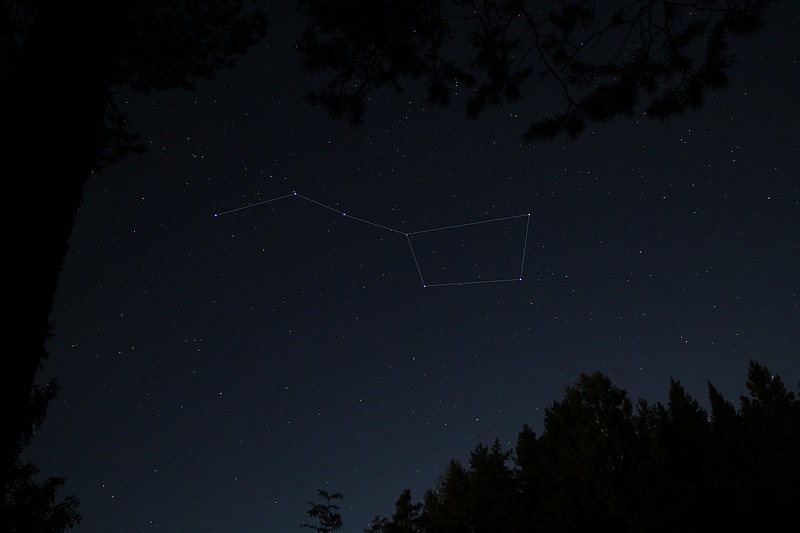
And there is beauty in the sky! The horizon is barely noticeably illuminated by the setting sun, the entire sky is strewn with sparkling diamonds of stars, the tops of the trees are slightly silvered by the almost full moon hiding behind the forest.
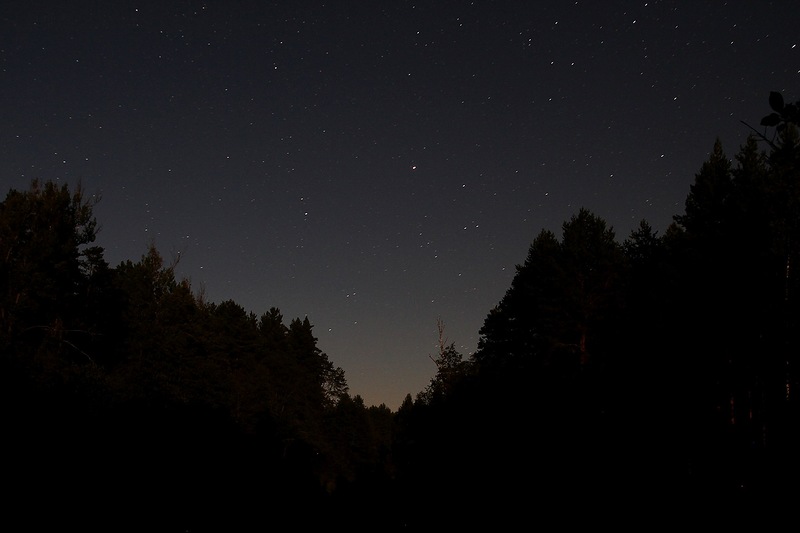
The fire is burning down, illuminating the red paws of the spruce tree, next to which we made a halt on the top of a high cliff near the bend of the Snigirevka River. The hypnotic and enchanting sounds of a jew's harp and a tambourine made of genuine leather, according to all the rules, dried over the flame of a fire, are carried away into the deserted emptiness.
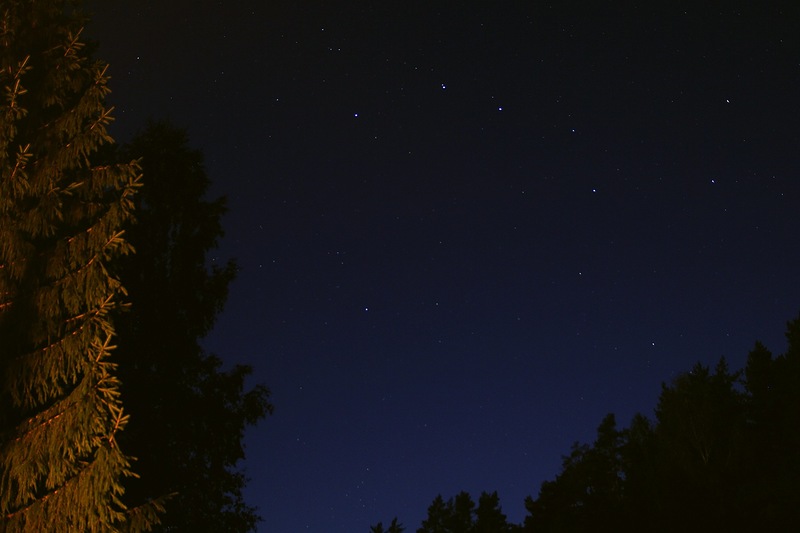
Nearby, a few steps away in absolute darkness among the pine trees, through whose branches the needle-like rays of the moon carefully break through, is a lake. It is absolutely round in shape, covered on all sides by forest, and floating along the shore round leaves egg pods. Sometimes there is a faint splash, either of a frog jumping into the water, or of a mermaid luring an unwary traveler. And in the grass, timid fireflies burn like green swamp lights, extinguishing their light at any rustle or reflection of a flashlight. And if you turn off the flashlights and stand in complete darkness, the surrounding reality is completely transformed. The tops of the trees are illuminated by all kinds of silvery shades of moonlight, the diamond dust of the stars is reflected in the water, everything around looks magical and crystal-silver.

Let's end this lyrical digression and return to our constellation. It has been known since ancient times, although different nations called differently. In Ancient Rus' it was the Elk, among other peoples it was the Plow, the Cart, the Seven Wise Men, etc. Greek myth tells that the beautiful nymph Callisto was transformed by Zeus into the Ursa to save her from Hera's revenge. In Chinese astronomy, the seven stars of the dipper are called the Northern Dipper (Beidou). In ancient times, the handle of the ladle pointed almost to the pole and was used by the Chinese to keep time. The Latin name for the constellation Ursa Major is Ursa Major. The constellation appears on some flags: on the flag of Alaska along with the North Star, Irish radical organizations (IRA), and the ancient flag of White Sea Karelia.

The stars that make up the bucket are marked here. Traditionally, they are named by the letters of the Greek alphabet, starting with the brightest star in descending order of brightness. Although in Ursa Major this rule fails - epsilon in it is brighter than alpha. In addition, each of the bucket stars has its own name. Like most stars, they have Arab origin(the culture of the Arabs served as a bridge across the intellectual chasm separating the fall of Rome from the Renaissance). Let's take a closer look at each of the stars.

α (alpha) - Dubhe means "bear" in Arabic. The name comes from the Arabic ahr ad-dubb al-akbar - "back of the big bear."
β (beta) - Merak- “lower back”. In its star system it shines 69 times brighter than the sun.
Using these two stars you can find the North Star, which points north. To do this, you need to mentally draw a line through the two stars (Dubhe and Merak) of the “wall” of the bucket opposite the “handle”, on which to plot five times the distance between these extreme stars. Near the end of this line is the North Star. The direction to the North Star coincides with the direction north, and its height above the horizon coincides with the latitude of the observer.

γ (gamma) - Phecda- "hip".
δ (delta) - Megrets- “root” (beginning of the tail). The faintest of the bucket stars, apparent magnitude +3.32. Located at 81 light year from us, about one and a half times larger and heavier than the sun, while being 14 times brighter.
ε (epsilon) - Aliot- the most bright Star constellation, 0.05 magnitudes superior to Dubhe. By right, she should be the alpha, but this is how it happened historically. It is in 33rd place in brightness among all stars in the visible part of the sky. Historically, this star has been used in maritime navigation.
ζ (zeta) - Mizar- “sash” or “loincloth”. People with good eyesight see another star next to Mizar, called Alcor. Ability to see Alcor - traditional way vision tests. This pair is also called "Horse and Rider" and is the most famous double star system. The full-size photos on this page also show both stars.
There is also a legend that supposedly in ancient Egypt, young men who could distinguish these stars were recruited into the elite troops of the pharaoh. This was proof that his vision was sharp enough. Versions of the legend feature Greek archers or Indian hunters. There is no confirmation of the reality of these facts. In addition, Mizar and Alcor are easily distinguishable as separate stars even with average visual acuity.
η (eta) - Benetnash or Alkaid from the full Arabic name al-Qa'id banat our, which means "leader of the mourners." This poetic image is taken from the Arabic folk understanding of the constellation Ursa Major (Hearse and Mourners). The constellation appears as a funeral procession: in front are mourners, led by a leader, followed by a funeral bier.
It is the third brightest star in the constellation and 35th on the list of the brightest stars in the sky. Benetnash is located about 100 light years from the Sun. With a surface temperature of 22,000°K, it is one of the hottest stars that can be seen with the naked eye.
This is where I will end the astronomical excursion, read the report on kayaking on the Snigirevka River, during which these pictures were taken. (the link is not working yet, the report is being completed)
Message quote
How to find stars in the sky
Starry sky
Two things never cease to amaze me - the starry sky above and the moral law within us.
Immanuel Kant
At night, thousands of stars flash in the sky, and the picture of the starry sky always delights and amazes us.
And in order to navigate in this sea of sparkles of the universe, the stars in the sky were united into constellations. Total 88 constellations, of which 12 belong to . The stars in the constellations are designated by Greek letters, and the brightest of them have their own name.
So, night came, garlands of stars flashed in the sky, and the Milky Way, our Galaxy, stretched like a white river across the sky. Let's look together at this multitude of distant suns and find the constellations.
Let's start with the summer-autumn sky
Let's get acquainted with the 4 constellations of the northern sky:
Are looking for Ursa Major and Ursa Minor, Cassiopeia and the Dragon.
In the middle latitudes of our country, these constellations, close to the North Pole of the world, are non-setting.
Even people far from astronomy can find in the sky Ursa Major, due to her great recognition the bucket becomes the starting point to search for many other constellations.
So let's start with Ursa Major. Bucket in late summer and autumn - in the north, in winter - in the northeast. 
Let's find the two extreme stars of this bucket. If mentally draw a straight line through these two stars, then the first bright star will be polar Star constellations Ursa Minor. The rest of the stars are located from it towards the handle of the larger bucket. Ursa Minor.
Poems from a children's astronomy site will help you remember the stars. ![]()
URSA GREAT
I recognize it by the BUCKET!
Seven stars sparkle here
Here's what their names are:
DUBHE illuminates the darkness,
MERAK is burning next to him,
On the side is FEKDA with MEGRETZ,
A daring fellow.
From MEGRETZ away
ALIOT is located
And behind him - MITZAR with ALCOR
(These two shine in unison.)
Our ladle closes
Incomparable BENETNASH.
He points to the eye
The path to the constellation BOOTES,
Where the beautiful ARCTURUS shines,
Everyone will notice him now!
………………….
Let's find a constellation Dragon.
It seems to stretch between the buckets Ursa Major and Ursa Minor, leaving towards Cepheus, Lyra, Hercules and Cygnus. More about these constellations later.
Constellation Cassiopeia.
Look at the second star from the end handles of the Ursa Major bucket. The bright star bears the name Mizar, and next to it is Alcor. From Arabic, Mizar is a horse, and Alcor is a rider.
Do a mental straight from Mizar through the North Star and beyond approximately the same distance. Constellation in the form Latin letter W, That's what it is Cassiopeia. ![]()
We should now be able to find constellations Ursa Major and Ursa Minor, Cassiopeia, Dragon.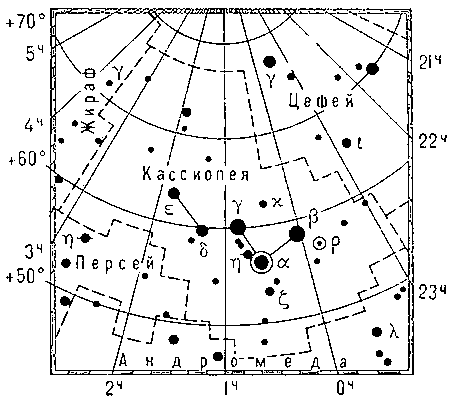
And we are looking for a few more constellations
Cepheus, Perseus, Andromeda, Pegasus, Auriga and Pleiades
Constellation Cepheus
In summer, being outside the big city, you will be able to see a strip of the Milky Way stretching from south to northeast. Between Draco and Cassiopeia you will find a constellation that resembles a pentagon or a house with a roof, which seems to “float” along the Milky Way. This constellation Cepheus. It is located just between the “break” of the Dragon and Cassiopeia, and the “Roof of the House” is not strictly directed to the North Star.
You can connect the stars α and β Cassiopeia and extend this line a little.
Perseus
In August it is a little to the left and lower Cassiopeia, you can test yourself by drawing a line between the stars γ and δ Cassiopeia and extending three times further.
Andromeda
Pay attention to the chain of stars stretching from Perseus towards the south. This is a constellation Andromeda. If you draw a line from the North Star through Cassiopeia, this line will also point to the central part Andromeda. The central bright star of the constellation is Mirah. Above it on moonless nights outside the city you can see faint hazy speck. This is famous The Andromeda Nebula is a gigantic spiral galaxy M31, the most distant object visible to the naked eye. The distance is about 2.5 million light years. 
Pegasus
Pegasus wonderful its square, formed by four stars.
And up and to the left of the extreme star of the Pegasus square are visible three bright stars of the Andromeda constellation. Together they form a bucket.
The δ, γ, ε and α of Cassiopeia will indicate the Pegasus square; these two lines will intersect just in the area of the Pegasus square. 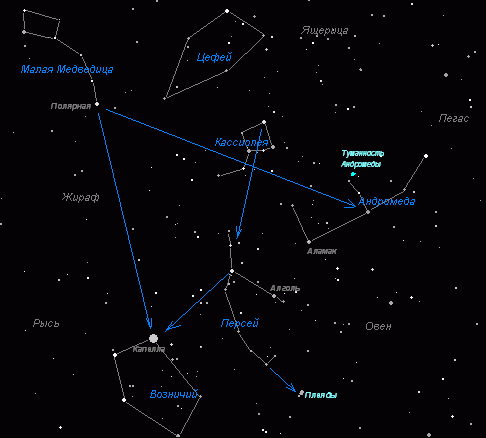
Auriga
You may have noticed a bright yellow star to the left and below Perseus. This Chapel- the main star of the constellation Auriga, which is visible under the constellation Perseus.
If you follow the chain of stars in the constellation Perseus, you will notice that the chain first goes vertically down (4 stars), then turns to the right (3 stars). If you continue straight to the right from these three stars, you will find a silvery cloud; upon careful examination, it will disintegrate into 6-7 miniature “bucket” stars. That's what it is diffuse stellar Pleiades cluster, included in the constellation Taurus.
……………………………
We are looking for Vega with Lyra, Swan, Orla, Delphine, And summer-autumntriangle
Let's return to the constellation Draco
The Dragon as if it extends between the buckets of Ursa Major and Ursa Minor, going towards Cepheus, Lyra with Vega, Hercules and Cygnus.
At the constellation Dragon, There is four stars in the form of a trapezoid, forming "head" of the Dragon in its western part.
We are looking for Vega, in August - September the star is clearly visible in the southwest.
Bright White Star not far from the "head" of the Dragon and there is Vega, one of the brightest stars northern sky. 
Draw a direct line from the extreme star of the "bucket"» Ursa Major (Dubge) through the "head" of the Dragon.
Vega will lie on the continuation of this line. Several stars form a figure reminiscent of a parallelogram - Lyra constellation. Vega - staraLyra constellation. After Arcturus (aBootes), is the second brightest star in the northern sky. Vega's brightness is +0.03m.
Summer-autumn triangle
Vega- one of the peaks summer-autumn triangle, the remaining peaks of which are bright stars Altair (Alpha Eagle) and Deneb (Alpha Cygnus)).
Swan
One of the most beautiful constellations in our sky - Swan is a cross with a bright star α Cygnus (Deneb) at the top, it looks like a bird flying across the sky or a cross,
"Northern Cross". You can find it to the left of Lyra. 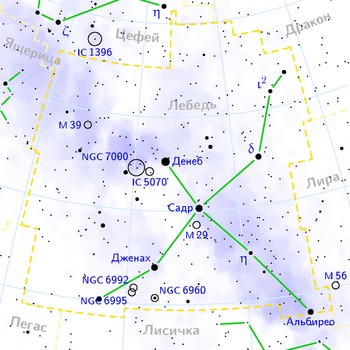
Eagle
Let's find the constellation Aquila. Look down from Vega and about halfway to the horizon you will spot a bright star - Altair(α Eagle). Altair together with Deneb and Vega form
summer-autumn triangle. 
Brightest in the evening world
Blue VEGA in LYRA!!!
I'm amazed by the beauty
And so our DRAGON froze!
Between Vega and DENEB
Draw a dotted line to the South -
There the EAGLE flies across the sky,
And ALTAIR sparkles!
All summer Summer Triangle visible in the south and southeast, in autumn - high in the south and southwest.
To the left of Altair you will find a weak constellation Delphinus, The constellation is beautiful, it resembles one emerging from the water dolphin
Summer is the period of the Perseid meteor shower., which lasts from July 17 to August 24 from maximum August 12, against the backdrop of scattered stars and the Milky Way, meteors (“shooting stars”) will fly by every now and then with bright flashes. Do not miss!!
…….
Other constellations of the summer sky.
Our summer nights are white, the stars are visible only at the end of August, but for the sake of order I will write about the summer sky.
Bootes constellation α Bootes (Arcturus).
To the left of Bootes is a semicircle facing downwards - constellation Corona Borealis, even further to the left Hercules constellation, - a quadrangle with broken lines diverging from its corners (the arms and legs of Hercules).
Under the constellation Hercules there is a constellation Ophiuchus, looking like an irregular polygon, and left and right from him the constellation Snakes.
Bright stars of the summer sky! 
Below the constellations Serpens and Ophiuchus is the constellation Scorpio, which resembles this animal. And to the right and below the constellation Libra.
Under the constellations Eagle and Shield located Sagittarius constellation.
Scientists suggest that it is in the direction of this constellation that the center of our galaxy is located.
Below the constellations Pegasus and the Little Horse is constellation Aquarius. It is easily recognized by the so-called “propeller” and four stars that resemble this object.
.............................
Constellations of the winter sky
From late autumn and winter we are looking for Gemini, Orion, Taurus, Auriga, Canis Minor, Canis Major.
In January, at about eight o'clock in the evening, we will find the Big Bear's bucket. Let's draw a straight line from the weakest star of the bucket (Megrets) through the rightmost star of the bucket (Merak) to the East. On the path of your straight line you will meet two bright stars located one above the other. These are the main stars Gemini constellation. Ta the star that is higher -Castor, lower and brighter - Pollux. 
In the south and southeast we see the most beautiful picture winter constellations. Seven stars brighter than second magnitude are visible in a small area of the sky. Yellow is visible almost at the zenith Chapel of the Auriga, under it - orange Aldebaran, to the left and below - Betelgeuse And Rigel, stars of Orion. Floats just above the horizon Sirius, shimmering with all the colors of the rainbow. On the left, in the southeast, a yellowish color is visible Procyon(α Canis Minor) and Pollux from the constellation Gemini.
Unfortunately, Sirius is practically invisible at our latitudes.
The main character in the picture of winter constellations is the hunter Orion. Its seven brightest stars are instantly memorable: three bright stars form Orion's belt, above it, closer to the constellation Gemini, there is a reddish Betelgeuse, and to the right is a hot star Bellatrix(they mark the hunter's shoulders), and below is a bright star Rigel and Saif's star point to his feet. 
By the way, top star Orion's belt is located almost at the celestial equator, therefore, those stars below it belong to the southern hemisphere of the sky, those above belong to the northern hemisphere.
Below Orion's belt there is a small nebulous speck. This is the Orion Nebula, a gigantic cloud of interstellar gas, the cradle of a new generation of stars.
To the right and above the hunter is the constellation Taurus, it extended to the right letter U. The bull is furious and rushes towards Orion; Aldebaran notes the red eye of Taurus. The body of Taurus is marked with a small scoop Pleiades.Pleiades- the brightest scattered star cluster
earth's sky. A person can see 6-7 stars in the Pleiades with the naked eye. 
Orion
Not afraid of winter and cold,
Having belted myself tighter,
Equipped for hunting
ORION performs
Two stars from the major leagues
IN ORION - this is RIGEL
In the lower right corner,
Like a bow on a shoe.
And on the left epaulette -
BETHELGEUSE shines brightly.
Three stars diagonally
Decorate the belt.
This belt is like a hint.
He is a heavenly pointer.
If you go to the left,
Miracle- SIRIUS you will find it.
And from the right end
Path to the constellation TAURUS
He points straight
Into the red eye ALDEBARANA.
Under Orion's feet is the small constellation Hare, and to his left, low above the horizon, is the constellation Canis Major. His main star Sirius is the brightest in the entire night sky of the Earth. Orion's other dog Small Dog, marked bright Procyon, is under Gemini.
To the left of Taurus under the constellation Perseus, familiar to us since the summer, find the constellation Charioteer(just under it there will be those already familiar to us Twins). There is a bright star in the constellation Auriga, even brighter than Aldebaran. This Chapel.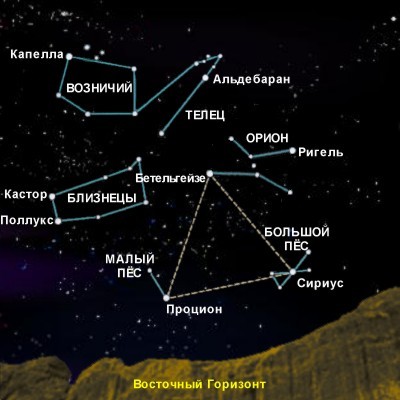
Winter triangle
We'll find it again Betelgeuse(orange bright star in Orion) and Procyon. Below Betelgeuse and to the right of Procyon low above the horizon we will see (if we see!) a bright white flicker Sirius - brightest star Earth's starry sky!
Sirius - Procyon - Betelgeuse form winter triangle stars 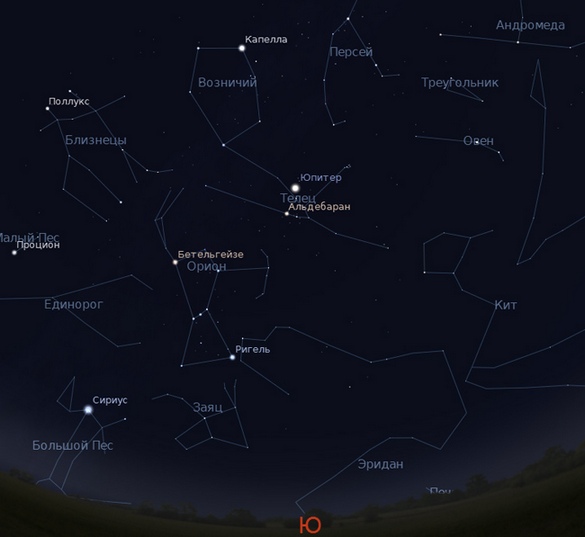
Unfortunately, the constellation Canis Major is a southern constellation and at the latitude of Moscow it rises low above the horizon, i.e. almost invisible.
If you decide to rush to the latitude of the Egyptian resorts in winter, then under Sirius you will find another bright star - Canopus(constellation Carina) is second The brightest star in the earth's sky is after Sirius.
The brightness of Sirius is minus 1.4m, that of Canopus is minus 0.6m. Shine Chapels +0.1m, Aldebarana +0.9m. And the shine North Star only 2m. 
…………………..
Constellations of the spring sky.
Let's connect North Star with two extreme stars Ursa Major and extend this line below. This will lead us to constellation Leo. There is a notable bright star in this constellation Regulus(α Leo).
Located between the constellations Leo and Gemini constellation Cancer.
To the left of the constellation Leo there is a group of faint stars - constellation Coma Berenices.
Between the handle of the Ursa Major dipper and the Coma of Veronica you will see two stars forming constellation Canes Venatici.
Bootes constellation. Resembles an elongated pentagon with a bright star in the lower corner α Bootes (Arcturus). We'll find Arcturus, it is enough to extend the line between the two outermost stars of the handle of the Ursa Major dipper downwards and here it is.
By connecting δ, ε and α Bootes, and extending this line down, we find Virgo constellation containing a bright star Spica (α Virgo).
…………………..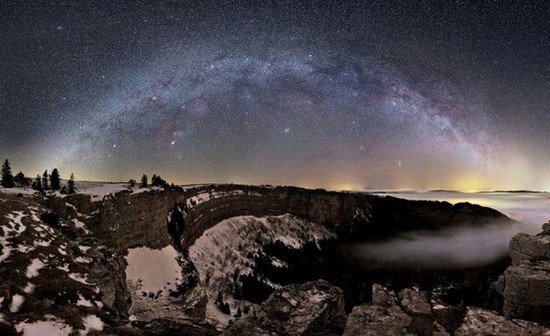
The stars are shining, shining...
Sometimes I can’t even believe it
That the Universe is so big.
Into the pitch-black sky
I look, forgetting everything in the world...
Still, it's great
That the stars shine for us at night!
................
For observations, it is good to have a flashlight that produces red light; it does not interfere with the adaptation of the eye to the dark. It is enough to put a red cloth on a regular flashlight. In addition, you will need a star map (preferably with an overlay circle). A similar map can be found in the Astronomical Calendar.
Well, how did you manage to find the pearls of the starry sky?
.................
I also have a star theme:
Constellations and stars in myths and legends
Constellation Big Dipper (Latin name) is probably known even to a preschooler. Finding a large bucket of seven stars in a clear sky will not be difficult for anyone. However, the ladle is not the entire constellation, but only the tail and part of the body of an imaginary celestial bear. To the right and below the bucket you can find several more stars that make up the paws and head. In fact, due to the Earth's rotation around the Sun, the night sky also appears to rotate around the pole throughout the year. Therefore, the Big Dipper's bucket turns and changes its position in the sky. So, in autumn and winter, the constellation appears at nightfall, low above the horizon in the northern part of the sky. And in spring and summer you should look for it closer to the zenith, and inverted. If you look closely at the star z (it’s called Mizar - see the list of stars on the right), then even with the naked eye you can see another smaller star next to it. Its name is Alcor. Translated from Arabic, “Mizar” and “Alkor” mean “Horse” and “Rider”. Mizar and Alcor are one of the most accessible double stars for observation.
Stars
Mizar (and Alcor)
Benetnash
 Having found the Big Dipper in the sky, it’s easy to move on to her younger sister - Ursa Minor(lat.). If you draw a straight line through the stars a and b of Ursa Major (see figure), then it will pass slightly to the left of the Polar Star (a Ursa Minor), which is very close to the North Celestial Pole (in the figure it is shown as a red circle). However, due to the precession of the Earth's axis, the Celestial Pole moves across the sky over time. So, 3000 years ago, the star closest to the pole was the star b Ursa Minor, Kohab. This name comes from the Arabic "Kohab-el Shemali", which means "Star of the North".
Having found the Big Dipper in the sky, it’s easy to move on to her younger sister - Ursa Minor(lat.). If you draw a straight line through the stars a and b of Ursa Major (see figure), then it will pass slightly to the left of the Polar Star (a Ursa Minor), which is very close to the North Celestial Pole (in the figure it is shown as a red circle). However, due to the precession of the Earth's axis, the Celestial Pole moves across the sky over time. So, 3000 years ago, the star closest to the pole was the star b Ursa Minor, Kohab. This name comes from the Arabic "Kohab-el Shemali", which means "Star of the North".
Stars
Polar
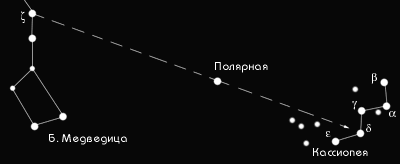 If you draw a straight line through the star z Ursa Major and through the North Star, it will point you to the constellation Cassiopeia (lat. Cassiopeia), which has the shape of the Latin letter W or M, depending on the time of observation (after all starry sky turns above us!). This characteristic figure of five bright stars is not the whole constellation. On dark, clear nights you can also see fainter stars.
If you draw a straight line through the star z Ursa Major and through the North Star, it will point you to the constellation Cassiopeia (lat. Cassiopeia), which has the shape of the Latin letter W or M, depending on the time of observation (after all starry sky turns above us!). This characteristic figure of five bright stars is not the whole constellation. On dark, clear nights you can also see fainter stars.
CIRCUPOLAR CONSTELLATIONS The polar star, “leading” the constellation Ursa Minor, and the constellations closest to it occupy a region of the starry sky called the circumpolar region. IN middle lane For our country, this area of the sky is always accessible to observation, and therefore it is quite natural that our excursion through the starry sky will begin with it. On the other hand, the circumpolar constellations include Ursa Major, whose seven-star bucket is well known to everyone since childhood. In addition to Ursa Major and Ursa Minor, the circumpolar constellations include the constellations Cassiopeia, Cepheus, Draco, and Giraffe in Lynx. How to find them in the starry sky? We should start with the Big Dipper. Autumn and winter evenings its bucket of seven stars is clearly visible in the northern sky. In spring and summer in the evenings this bucket is located much higher, and then it has to be found in the vicinity of the zenith. In each constellation, it is important to first find its most important, characteristic part, and only then, with a more detailed acquaintance, everything else. In Ursa Major, the well-known bucket serves as the “backbone” of the constellation. There is a known method that allows you to find the North Star using the Ursa Major bucket. To do this, through the two extreme stars in the bucket we mentally draw (towards the convexity of the bucket handle) a slightly curved curve. At a distance almost five times the distance between the stars α and β of Ursa Major, it will pass through a second magnitude star (2m), which is the famous Polaris. A smaller bucket with a strongly curved handle stretches from it towards the Big Dipper - main part constellation Ursa Minor. Now it is not difficult to find the constellation Cassiopeia, located in the sky in relation to the North Star in the direction opposite to Ursa Major. Its main part forms a figure reminiscent of the letter “M” stretched out by its legs. Note that in some positions this celestial letter looks upside down, and then it resembles the letter of the Latin alphabet “W”. Between Cassiopeia and Ursa Minor is the constellation Cepheus. It is less noticeable than the listed constellations, and its main stars do not form any characteristic, conspicuous figure. Therefore, when searching for this constellation (as well as others similar to it), you need to search for the stars you are interested in sequentially, one after another, “starting” from already known stars of other constellations. In this case, of course, during the search process you should constantly compare the sky with a star map. So, for example, to find α Cepheus, we must take into account that it is located on the continuation of the straight line connecting α and β Cassiopeia, at a distance four times greater than the distance between these stars. Having found α Cepheus, we easily find first the nearest and then more distant stars of the same constellation. The constellation Draco meanders between Ursa Major and Ursa Minor. Its characteristic chain of stars is connected on the map by a broken line. The irregular quadrangle of stars that completes this broken line forms the head of a fantastic monster. The constellations Giraffe and Lynx are among the most unremarkable in the starry sky. They include only faint stars, which should be searched for separately between the constellations Ursa Major and Cassiopeia. There are no traces of any characteristic figures here. In the whole sky - this is the “darkest”, the poorest bright stars region. The ancient Greeks told funny legends about Ursa Major and Ursa Minor. Here is one of them. Once upon a time, in ancient times, King Lycaon, who ruled the country of Arcadia, had a daughter named Callisto. Her beauty was so extraordinary that Callisto risked competing with Hera, the goddess and wife of the almighty supreme god Zeus. Jealous Hera eventually took revenge on Callisto: using her supernatural power, she turned her into an ugly Ursa. When Callisto's son, young Arkas, one day returning from a hunt, saw a wild beast at the door of his house, he, suspecting nothing, wanted to kill his mother, the Bear. But Zeus, who had long been partial to Callisto, prevented the crime. At the most critical moment, he held Arcas’s hand, and took Callisto to his sky forever, turning him into a beautiful constellation. At the same time it was turned into Ursa Minor and beloved dog Callisto. Arcas did not remain on Earth either: carried away by “constellation creation,” Zeus turned him into the constellation Bootes, doomed to forever guard his mother in the heavens. That is why the main star in the constellation Bootes is called Arcturus (this name, in all likelihood, comes from the word “arctophylax”, which in Greek means “guardian of the bear”). The story of the constellations Cepheus and Cassiopeia is even more romantic (we present one version of the legend). According to the stories of the ancient Greeks, Ethiopia was once ruled by the legendary king Cepheus. One day his wife, Queen Cassiopeia, had the imprudence to show off her beauty to the mythical inhabitants of the sea - the Nereids. Driven by understandable female jealousy, they complained to the god of the sea, Poseidon, who released a terrible sea monster onto the shores of Ethiopia. Countless disasters befell Ethiopia - a monster devastated the flourishing country. Then Cepheus resorted to extreme measures: in order to appease Poseidon, he gave his only beloved daughter Andromeda to be devoured by the monster. The beautiful Andromeda was chained to a coastal rock and, shedding tears, obediently awaited the tragic outcome. And at this time, on the other side of the world, one of the most popular legendary heroes, Perseus, accomplished an extraordinary feat. He entered a secluded island where gorgons lived - monsters in the form of women whose heads were swarming with snakes instead of hair. The look of the gorgons was so terrible that anyone who dared to look into their eyes was instantly petrified. But nothing could stop the fearless Perseus. Seizing the moment when the gorgons fell asleep, Perseus cut off the head of one of them - the gorgon Medusa. At the same moment, the winged horse Pegasus flew out of the severed body of Medusa. Perseus immediately jumped on Pegasus and rushed to his homeland. Flying over Ethiopia, he noticed Andromeda chained to a rock. Just at that moment, a monster emerged from the depths of the sea and rushed towards Andromeda. But then the brave Perseus entered into a desperate battle with the monster. This struggle continued for a long time. In the end, Perseus won only because he directed the deathly gaze of Medusa's severed head at the monster. The monster petrified, turning into an island, and Perseus, unchaining Andromeda, returned her to her father. This long story ended with the cheerful wedding of Perseus and Andromeda, and the fantasy of the ancient Greeks immortalized all its characters in the bizarre figures of the constellations. Here we will describe only two of them. The rest will be discussed in the next section. The constellation Draco is also associated with ancient myths. According to the stories of the ancient Greeks, it depicts the mythical dragon who guarded an extraordinary garden with golden apples. According to another version, the heavenly Dragon depicts a monster that almost swallowed Andromeda. It is difficult to deny all these ancient myths both their naivety and their peculiar charm. In how many magnificent works of art they were embodied! But the most lasting monuments of the poetic myth-making of antiquity, undoubtedly, remain the constellations. The constellations Giraffe and Lynx have a completely different origin. For the first time, the constellation Giraffe is depicted on the star map of Barchius, the son-in-law of the great Kepler. The map was published in 1624, and although Barchius does not say how the constellation Giraffe arose, one can think that it appeared in the era of great geographical discoveries as a kind of monument to travelers to exotic African countries. The origin of the Lynx constellation is completely curious. It was introduced in 1660 by the famous Polish astronomer Hevelius. The motive was simple; according to Hevelius, “in this part of the sky there are only small stars, and you need to have lynx eyes to distinguish and recognize them.” However, Hevelius did not overestimate his ingenuity and wrote that “whoever is not satisfied with my choice can draw here something else that he likes more, but in any case, there is too big a void in the sky to leave it unfilled.” . After that general overview circumpolar constellations, let's take a closer look at each of them separately.
Ursa Major is a constellation in the northern hemisphere. Seven stars form the most famous figure in the sky. This is a ladle, which with its two extreme stars Dubhe and Merak gives direction to the North Star. The brightest star is Alioth, and the most famous dual system- Mizar - “horse” and Alcor - “rider”. It is believed that the one who distinguishes between these two stars has keen vision.
The constellation contains two spiral galaxies, M81 and M101, which can be observed with a small telescope. M81 is interesting because it is very similar to our Galaxy. Nearby is the small galaxy M82, which experienced a powerful explosion just a few million years ago. This event is of great interest for astronomy, since it sheds light on the processes of formation and development of galaxies.
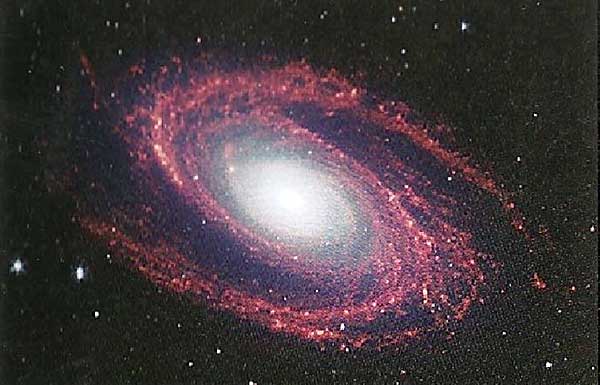
Spiral galaxy M81. A composite image obtained from images from the ground and from space.
In Ursa Major there is another interesting object - the planetary nebula M97 "Owl", which received its name for its resemblance to this bird. It can be observed with a small telescope, since the total brightness of the nebula is 11”.
In ancient Greek mythology, the young goddess of the hunt Artemis roamed the mountains and forests in search of game. The most charming in the goddess's retinue was the maid Callisto. When Zeus (Jupiter in Roman mythology) saw the nymph, he was amazed by her beauty and youth. However, the maids of Artemis did not have the right to marry. To take possession of Callisto, Zeus resorted to a trick and appeared before her in the form of Artemis. Zeus achieved his goal and Callisto gave birth to a son, Arkad, who quickly grew up and became an excellent hunter.
Zeus's jealous wife Hera found out about her husband's affair and brought down her anger on Callisto, turning her into an ugly club-footed bear, which Callisto's son Arkad later met in the forest. He could not know that it was his mother and shot her. Zeus, who vigilantly protected his beloved Callisto, at the last moment deflected the flying arrow.
After this, Zeus turned Arkad into a small bear cub and carried him and the she-bear to heaven. There he left Callisto to shine in the form of the beautiful constellation Ursa Major, and Arcade - in the form of the constellation Ursa Minor.
Finding a constellation in the sky
The constellation is visible at latitudes from -30° to +90°. Best time for observation in spring, March and April. The constellation is clearly visible throughout Russia. Neighboring constellations: Dragon, Giraffe, Lynx, Leo Minor, Leo, Coma Berenices, Canes Venatici, Bootes.
Ursa Major is perhaps the most famous constellation that most observers will unmistakably find in the sky. This northern constellation really easy to find as its stars form an easily recognizable scoop shape. In autumn, the constellation is in the northern part of the sky.
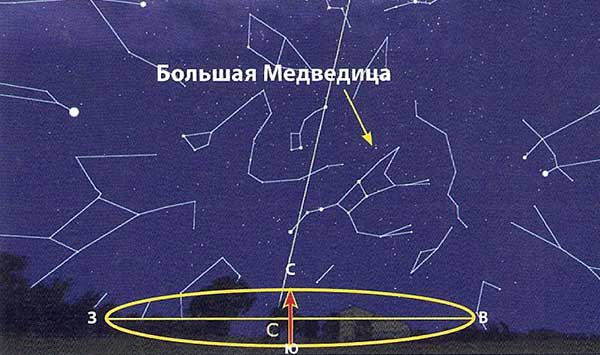
In winter, the Big Dipper moves east, and the “bucket handle” moves down. The bear seems to be climbing up into the sky. A widely known method for finding the North Star is using the two rightmost stars of the bucket, which are directed towards the desired object.
![]()
In the spring, Ursa Major begins its “descent from heaven” and moves to the west. At the end of summer, the constellation returns to the north again, occupying a horizontal position. Using the “bucket” you can determine local time quite accurately. An algorithm for solving this problem can be found on the Internet.
